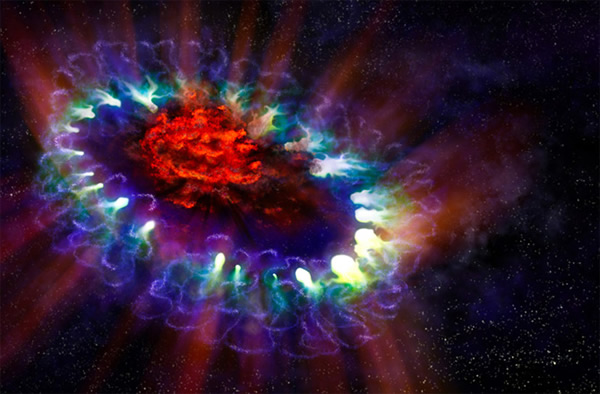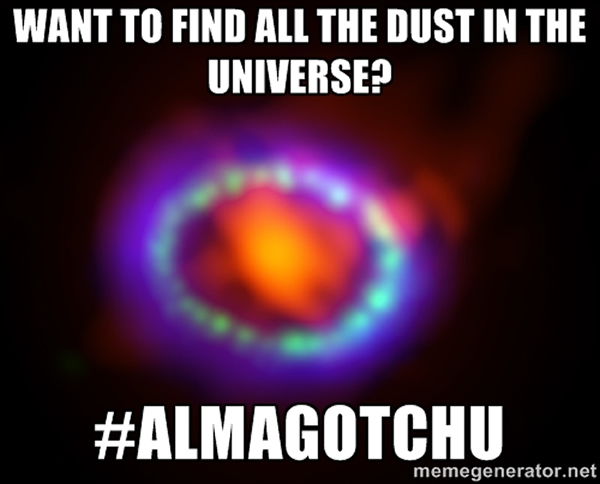Dust Bunnies Discovered Around 'Dirty' Supernova
Artist conception of Supernova 1987A and its newly discovered dust cloud.
Dust. It’s a nuisance. It’s dirty. It makes you have to clean your house. And without it, we wouldn’t even be here. That’s why astronomers are so happy to find a whole lot of dust with a state-of-the-art radio telescope.
The Atacama Large Millimeter/Submillimeter Array (ALMA) promises great things. Located at one of the highest, driest spots on Earth, this new radio array lets astronomers explore a rich area of the electromagnetic spectrum that is difficult to access through the Earth’s atmosphere. It can see the birth of stars, the formation of galaxies, the origins of planets, and, oh yeah, dust.
Dust in the universe is actually quite fascinating. Tiny dust grains around young stars seed the formation of planets. Dust is also crucial to helping gas clouds cool so that they can collapse to form stars. Though dust is often made by very old middle-sized and smaller stars, that doesn’t explain how dust came to be early in the Universe’s history after only the most massive stars had exploded in supernovae. Though it seemed that supernovae could make some dust, it was not nearly enough.
This week, at the 223rd American Astronomy Meeting in Washington, D.C. astronomers announced that they had found the missing dust, or at least an important example of where it comes from.
Supernova 1987A blasted its way into existence just 27 years ago in the nearby Large Magellanic Cloud, allowing astronomers a chance to watch a supernova evolve right in front of their eyes (or telescopes). In the image above, a characteristic ring of material shows where the shock wave of the exploded supernova is in space, so that the remnants of the massive star that exploded can be found within that ring.
The team, led by Remy Indebetouw of the University of Virginia, pointed ALMA at supernova 1987A looking for warm dust, and they found it. A lot of it. The dust cloud seen has a full quarter of the mass of our sun! This is ample dust, produced by the star that went supernova, to explain where dust came from in the early universe, allowing the generations of star formation that eventually led to planets and people.
If dust is so ubiquitous, then why is it so hard to find? The dust is at a temperature that radiates most strongly in the millimeter and submillimeter range of the electromagnetic spectrum. These wavelengths are largely blocked from reaching Earth by the atmosphere, hence the need to build a telescope such as ALMA on such a high mountain with so little water vapor in the atmosphere.
Composite image of ALMA (orange), Hubble (green), ad Chandra (blue) data from SN 1987A.
R. Indebetouw et. al, A. Angelich (NRAO/AUI/NSF);NASA/STScI/CfA/R. Kirshner; NASA/CXC/SAO/PSU/D. Burrows et al. Modified with memegenerator.net.
Want to find some of the dustiest spots in the Universe? Well, ALMA Gotchu.
This work has been accepted to Astrophysical Journal Letters, and a preprint is available at arXiv.org.(Jan 8, 2014 02:59 PM ET // by Nicole Gugliucci)













